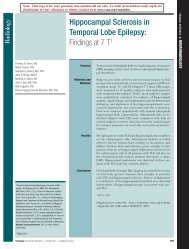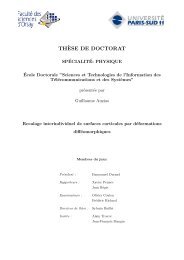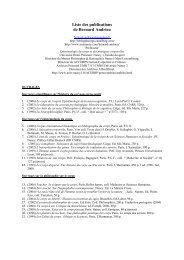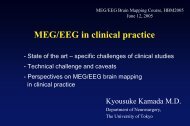Integrating MEG, EEG and fMRI data
Integrating MEG, EEG and fMRI data
Integrating MEG, EEG and fMRI data
You also want an ePaper? Increase the reach of your titles
YUMPU automatically turns print PDFs into web optimized ePapers that Google loves.
<strong>MEG</strong>/<strong>EEG</strong> Brain Mapping Course<br />
HBM2006<br />
Florence, June 11, 2006<br />
<strong>Integrating</strong> <strong>MEG</strong>, <strong>EEG</strong> <strong>and</strong> <strong>fMRI</strong> <strong>data</strong><br />
Gian Luca Romani<br />
Institute of Advanced Biomedical Technologies – ITAB<br />
“G. D’Annunzio University” Foundation<br />
<strong>and</strong><br />
Department of Clinical Sciences <strong>and</strong> Bioimaging<br />
“G. D’Annunzio” University,<br />
Chieti, ITALY
Outline<br />
• <strong>MEG</strong> - <strong>EEG</strong> – <strong>fMRI</strong> integration: respective<br />
advantages <strong>and</strong> limitations<br />
• Basic methods<br />
• Examples of integration in the study of primary<br />
areas, in cognitive neuroscience, <strong>and</strong> in the<br />
clinical field<br />
– Somatosensory system: pain vs. no-pain activations <strong>and</strong><br />
somatotopic properties<br />
– Passive listening to sounds from different locations<br />
– Functional reorganization in cases of malformation of<br />
cortical development<br />
• Some critical remarks<br />
• Conclusions <strong>and</strong> perspectives
<strong>MEG</strong> <strong>and</strong> <strong>fMRI</strong> equipment<br />
at ITAB – University of Chieti<br />
<strong>MEG</strong><br />
<strong>fMRI</strong><br />
165-channel wholehead<br />
system<br />
(by end 2006, a new<br />
500-channel system)<br />
1.5T Siemens Vision<br />
(by end 2006, a new<br />
3T Philips Achieva)
<strong>MEG</strong> - <strong>EEG</strong> – <strong>fMRI</strong> integration:<br />
respective advantages <strong>and</strong><br />
limitations
<strong>fMRI</strong> – <strong>MEG</strong> (<strong>EEG</strong>) relationship<br />
<strong>fMRI</strong><br />
Generated by oxygenated<br />
hemoglobin in the blood<br />
Functional images are<br />
directly related to<br />
structural images<br />
No source model required<br />
High spatial resolution (but<br />
depends on vascularization)<br />
Low time resolution (limited<br />
by hemodynamic response)<br />
Resolution independent of<br />
source depth<br />
<strong>MEG</strong> (<strong>EEG</strong>)<br />
Generated by intracellular<br />
currents<br />
Functional images are not<br />
directly related to<br />
structural images<br />
Imaging depends on source<br />
<strong>and</strong> head models (<strong>and</strong><br />
conductivity, for <strong>EEG</strong>)<br />
Low spatial resolution<br />
(related to source type)<br />
High time resolution (better<br />
than 1 ms)<br />
Poor resolution for deep<br />
sources
<strong>MEG</strong>, <strong>EEG</strong>, <strong>fMRI</strong> spatio-temporal<br />
properties<br />
Spatial resolution (mm)<br />
10<br />
8<br />
6<br />
4<br />
2<br />
<strong>EEG</strong><br />
<strong>MEG</strong><br />
<strong>fMRI</strong><br />
0<br />
10 -3 10 -2 10 -1 10 0 10 1 10 2<br />
Temporal resolution (s)<br />
10 3
Basic methods
How can we integrate <strong>MEG</strong>, <strong>EEG</strong>, <strong>and</strong> <strong>fMRI</strong> ?<br />
a. Simple superposition of the equivalent current<br />
dipoles (ECDs) <strong>and</strong> the <strong>fMRI</strong> active areas<br />
b. Dipole seeding, i.e. utilize <strong>fMRI</strong> activation<br />
maps to constrain <strong>MEG</strong> inverse solutions<br />
(Ahlfors et al., J Neurophysiol 1999)<br />
c. Use of distributed sources, <strong>and</strong> regularization<br />
of Linear inverse Estimation (LE) for <strong>EEG</strong><br />
<strong>and</strong>/or <strong>MEG</strong> <strong>data</strong>, with inclusion of <strong>fMRI</strong><br />
constraints (Liu et al., PNAS 1998; Babiloni et al.,<br />
Int J Bioelectromagnetism 1999; etc.)
How can we integrate <strong>MEG</strong>, <strong>EEG</strong>, <strong>and</strong> <strong>fMRI</strong> ?<br />
a. Simple superposition of the equivalent current<br />
dipoles (ECDs) <strong>and</strong> the <strong>fMRI</strong> active areas<br />
• Data from <strong>MEG</strong> <strong>and</strong> <strong>fMRI</strong> are independently<br />
analyzed<br />
• The active regions identified by the two<br />
techniques are merged in a common reference<br />
system (MRI) using fiducial markers<br />
• <strong>MEG</strong> sources (ECDs) are additionally<br />
transformed into the Talairach space
How can we integrate <strong>MEG</strong>, <strong>EEG</strong>, <strong>and</strong> <strong>fMRI</strong> ?<br />
b. Dipole seeding, i.e. utilize <strong>fMRI</strong> activation maps<br />
to constrain <strong>MEG</strong> inverse solution<br />
• The brain areas identified as active by <strong>fMRI</strong><br />
during a specific task are used to guide the <strong>MEG</strong><br />
inverse solution<br />
• It is not possible to simply position the <strong>MEG</strong><br />
source in a fixed location, since <strong>fMRI</strong> <strong>and</strong> <strong>MEG</strong><br />
detect different physical phenomena<br />
• The ECDs are let free to move inside a small<br />
volume, their orientation is let free as well, <strong>and</strong><br />
a figure of merit is optimized, in order to obtain<br />
the time course of each source
How can we integrate <strong>MEG</strong>, <strong>EEG</strong>, <strong>and</strong> <strong>fMRI</strong> ?<br />
c. Use of distributed sources <strong>and</strong> regularization of<br />
Linear inverse Estimation (LE)<br />
• The solution of the <strong>MEG</strong> (<strong>EEG</strong>) inverse problem<br />
with a distributed source model requires the<br />
solution of a linear equation such as:<br />
Ax – b = 0<br />
where A is the lead field matrix:<br />
# rows = # field (or potential) measurements (knowns)<br />
# columns = # dipole components (unknowns)<br />
x is a column vector of dipole components<br />
b is a column vector of measured field components<br />
(for a review, see: Del Gratta et al., Reports on Progress in Physics, 2001)
How can we integrate <strong>MEG</strong>, <strong>EEG</strong>, <strong>and</strong> <strong>fMRI</strong> ?<br />
d. Use of distributed sources <strong>and</strong> regularization of<br />
Linear inverse Estimation (LE)<br />
• since the number of dipole components (5,000-10,000) is<br />
much larger than the number of measurements (150-500),<br />
we must minimize the following expression (cost<br />
function):<br />
⎜⎜Ax - b⎜⎜ + λ 2 ⎜⎜Cx ⎜⎜<br />
where λ is the so-called regularization parameter <strong>and</strong> C is<br />
simply a weight matrix that depends on the head model.<br />
• By appropriately shaping C we can take into account the<br />
possible constraints used in various LE analysis methods<br />
(Minimum Norm, SLORETA, etc.), but also the <strong>fMRI</strong><br />
constraints
How can we integrate <strong>MEG</strong>, <strong>EEG</strong>, <strong>and</strong> <strong>fMRI</strong> ?<br />
• The functional information is used to force the linear inverse<br />
estimation weighting the minimization procedure with respect to<br />
the bold activation.<br />
• Anatomical <strong>and</strong> functional information can be used to delimit the<br />
source space to a given ROI. The activity of this specific ROI<br />
during time can be estimated using a linear inverse estimation.<br />
• λ (regularization parameter): by choosing the correct value for λ<br />
an equilibrium between goodness of fit <strong>and</strong> closeness to the model<br />
term ⎜⎜Cx ⎜⎜ is achieved.<br />
A possible method to calculate λ is the L-<br />
λ ≈ 0.0001<br />
curve criterion: if the model term ⎜⎜Cx ⎜⎜<br />
10<br />
is plotted vs. the <strong>data</strong> term ⎜⎜Ax - b⎜⎜ as<br />
3<br />
λ ≈ 0.001<br />
a curve parametrized by λ,an L-shaped<br />
10 2<br />
λ ≈ 0.01<br />
curve is obtained. The corner of L can be<br />
λ ≈ 0.1<br />
10<br />
seen as an equilibrium point between the<br />
1<br />
<strong>data</strong> term <strong>and</strong> the model term. (see<br />
10 -3 10 -2 10<br />
schematic <strong>and</strong> the reference: Hansen, P.C., SIAM<br />
-1<br />
⎜⎜Ax - b⎜⎜<br />
Rev. 34, 1992)<br />
⎜⎜Cx ⎜⎜
Sensorimotor <strong>EEG</strong>-<strong>MEG</strong> <strong>data</strong> can be<br />
“fused” in a finger movement<br />
paradigm, using the LE approach<br />
Regularization of LE permits to infer the time<br />
course of the source current density <strong>and</strong> to<br />
better discriminate the contribution from<br />
different neural districts in the pre- <strong>and</strong> postmotor<br />
period (Babiloni et al., Human Brain<br />
Mapping 2001)
Integration of <strong>fMRI</strong>-<strong>EEG</strong> (MRP) with regularization of LE<br />
allows better identification of the active areas, if we add the<br />
<strong>fMRI</strong> constraints<br />
Right index finger movement
Somatosensory system:<br />
pain vs. no-pain activations<br />
<strong>and</strong><br />
somatotopic properties
Exp.1 - Effect of stimulus intensity from motor<br />
to weak painful, <strong>MEG</strong> study I<br />
(Torquati et al., NeuroReport 2002)<br />
• Median nerve stimulation in 8 healthy subjects<br />
• Ten different levels of current intensity.<br />
Sensory Motor Weak painful<br />
I 0 I 1 I 2 I 3 I 4 I 5 I 6<br />
4.2 7.5 11 14 17 21 24<br />
I 7 I 8 I 9<br />
31 45 59 mA
Results<br />
motor strong motor weak painful<br />
I 1 I 5<br />
I 9<br />
SI - increase in amplitude from I1 to I5, then saturation: increasing<br />
synchronization mechanism of post-synaptic potentials, then “ceiling” effect on the<br />
involved myelinated Aβ fibers (nociceptive innervation in SI mainly represented by<br />
much slower Aδ <strong>and</strong> C unmyelinated fibres)<br />
SII - decrease for strong motor stimulation: “gating” effect due to the poor<br />
nociceptive specificity of the electrical stimulation involving possible interference<br />
in the evoked activation of the “non painful” <strong>and</strong> “painful” populations; increase for<br />
weak painful stim.: stronger attention to the stimulus, <strong>and</strong> amount of activated “non<br />
painful” neurons decreasing with the “gating” effect<br />
•Possible existence of two adjacent neuronal pools indistinguishable by <strong>MEG</strong>
Exp.2 – identification of anterior <strong>and</strong> posterior<br />
SII: spatial features, <strong>fMRI</strong> study<br />
Activation for non-painful stimuli<br />
cSI<br />
cSIIa<br />
iSIIa<br />
Ferretti et al., NeuroImage, 2003
Activation for painful stimuli<br />
cSI<br />
cSIIa<br />
iSIIa<br />
cSIIp<br />
iSIIp<br />
Ferretti et al., NeuroImage, 2003
Results<br />
• Evidence for a spatial segregation<br />
occurring in SII for neural population<br />
responding to painful stimulation with<br />
respect to that activated by non-painful<br />
stimulation<br />
• The “painful” population located more<br />
posterior than the “non-painful” area<br />
• Small distance between the two areas<br />
• No information on timing
Exp.3 - Identification of anterior <strong>and</strong> posterior<br />
SII: temporal features, <strong>MEG</strong> study II<br />
[example of dipole seeding]<br />
Torquati et al., Neuroimage 2005
Identification of anterior <strong>and</strong> posterior SII:<br />
temporal features<br />
[example of LE (MNE) with <strong>fMRI</strong> constraints]<br />
SI<br />
SIIa<br />
SIIp
Motor threshold<br />
Painful threshold<br />
SI<br />
iSII<br />
cSII
Results<br />
Mean Latencies<br />
ms<br />
90<br />
88<br />
86<br />
84<br />
82<br />
80<br />
( * p
Passive listening to sounds from different<br />
locations (<strong>fMRI</strong> <strong>and</strong> <strong>MEG</strong>)<br />
(Brunetti et al., Human Brain Mapping 2005)<br />
This study aimed at highlighting how the auditory system<br />
identifies the direction a sound is coming from. Activations of<br />
cortical areas during stimulation with sounds coming from a<br />
fixed source or, r<strong>and</strong>omly, from five different sources<br />
located in a horizontal half-space were studied with both<br />
<strong>MEG</strong> <strong>and</strong> <strong>fMRI</strong>
Passive listening to sounds from different<br />
locations (<strong>fMRI</strong> results)<br />
•Two main areas were found to be<br />
activated during auditory stimulation: the<br />
bilateral Heschl’s gyrus <strong>and</strong> the right<br />
superior temporal gyrus. Larger activation<br />
was found in the MIXED condition than in<br />
the LEFT <strong>and</strong> RIGHT conditions<br />
•Additionally, the right supramarginal<br />
gyrus was activated during the MIXED<br />
condition only<br />
•A right hemisphere specialization for<br />
auditory spatial processing seemed<br />
confirmed, as opposed to the language<br />
processing in the left hemisphere<br />
(Gazzaniga et al., 1998)<br />
•No information about timing was obtained<br />
from <strong>fMRI</strong><br />
MIXED<br />
RIGHT<br />
LEFT
Passive listening to sounds from different locations<br />
(example of simple superposition <strong>and</strong> of dipole seeding)<br />
<strong>MEG</strong> allowed identification of a bilateral activation in<br />
the Heschl’s gyrus, but no reliable localizations for the<br />
superior temporal gyrus <strong>and</strong> the supramarginal gyrus<br />
were obtained (sources too close)<br />
The last two areas were identified by constraining the<br />
sources in a cube with 4 mm side centered in the<br />
corresponding <strong>fMRI</strong> activation.
Passive listening to sounds from different<br />
locations (time course results)<br />
<strong>MEG</strong> permitted identification of<br />
the time sequence of activation for<br />
the three sources:<br />
1.Heschl’s gyrus (m. latency 138 ms)<br />
2.superior temporal gyrus (156 ms)<br />
3.supramarginal gyrus (162 ms)<br />
thus suggesting a hierarchical<br />
structure for the processing of<br />
sound localization features
Functional reorganization in cases of malformation of<br />
cortical development (MCD) - a TMS-<strong>fMRI</strong> study<br />
• Structural MRI, TMS, <strong>and</strong> <strong>fMRI</strong><br />
findings (paretic h<strong>and</strong> movement)<br />
obtained in 3 cases<br />
• A–C: Axial reconstructions from<br />
the T1-weighted 3D <strong>data</strong> sets<br />
• D–F: Results of TMS for<br />
stimulation of the affected <strong>and</strong><br />
contralesional hemispheres, with<br />
MEPs recorded simultaneously<br />
from target muscles of both the<br />
paretic h<strong>and</strong> (yellow MEPs) <strong>and</strong><br />
the non paretic h<strong>and</strong> (white<br />
MEPs).<br />
• H, J <strong>and</strong> L: <strong>fMRI</strong> activations for<br />
movement of the paretic h<strong>and</strong>.<br />
• M–O: illustration of TMS <strong>and</strong><br />
<strong>fMRI</strong> findings;<br />
(Staudt et al., J. Neurosurg., 2004)
A <strong>MEG</strong> coherence study on the same grop<br />
of patients (Belardinelli et al., 2006, in preparation)<br />
Coherent brain areas with paretic h<strong>and</strong> EMG in the β frequency range<br />
during forearm contraction. The coherence 3D mapping within the<br />
brain is obtained by means of different spatial filters (Linear<br />
Constrained Minimum Variance Beamformer <strong>and</strong> Sloreta)
A further possibility: identification of coupling<br />
direction<br />
Different direction evaluators were used: a Granger causality index (Kaminski et al,<br />
Biological Cybernetics, 2001), as well as two different indexes for the detection of<br />
coupling direction in chaotic oscillators (Rosenblum et al, Phys. Rev. Lett. 2004)<br />
have shown values indicating M1 as generator of the activity which comes to the<br />
cerebellum in case of paretic h<strong>and</strong> use. The cerebellum coherent activity is not<br />
present in case of contralateral (healthy) h<strong>and</strong> use
Pyramidal neurons: only<br />
1% of these neurons (low<br />
metabolic dem<strong>and</strong>), if<br />
synchronously active<br />
produce 90% of scalp<br />
<strong>EEG</strong>/<strong>MEG</strong><br />
Some critical remarks<br />
Stellate neurons (15% of neocortical<br />
neurons): strong metabolic/rCBF dem<strong>and</strong><br />
but no scalp <strong>EEG</strong> or <strong>MEG</strong> signals (closed<br />
electromagnetic fields)<br />
Moreover, <strong>MEG</strong>/<strong>EEG</strong> <strong>and</strong> <strong>fMRI</strong> may be sensitive to different<br />
phenomena (i.e. rhythm modulations vs. regional neural<br />
activation), or be affected by different “boundary” conditions
Cognitive <strong>fMRI</strong>-<strong>EEG</strong>-<strong>MEG</strong> <strong>data</strong> could not be “fused” in a<br />
working memory (WM) paradigm, since ERD/ERS of rhythmic<br />
activity can be studied with <strong>MEG</strong>/<strong>EEG</strong> much better<br />
Alpha ERD is evaluated by LE after the 1st (T1) <strong>and</strong> 2nd (T2)<br />
second of the delay phase<br />
<strong>fMRI</strong><br />
Babiloni et al., Clin. Neurophysiol. 2004
Neural plasticity after stroke<br />
<strong>MEG</strong> ECDs were always<br />
identified in both<br />
hemispheres of all<br />
patients featuring a<br />
good clinical function<br />
recovery;<br />
BOLD-<strong>fMRI</strong> activation<br />
was seldom observed<br />
(20% of same patients<br />
only): this could be<br />
related to the<br />
significantly impaired<br />
vasomotor reactivity<br />
those patients were<br />
still featuring<br />
Rossini et al., Brain 2004
Conclusions <strong>and</strong> perspectives<br />
• A combined use of <strong>MEG</strong>, <strong>EEG</strong> <strong>and</strong> <strong>fMRI</strong> may<br />
provide a unique tool for studying brain<br />
activity with both high spatial resolution <strong>and</strong><br />
high temporal resolution<br />
• Integration requires skill <strong>and</strong> care, but can be<br />
h<strong>and</strong>led routinely<br />
• Integration makes sense only if the same kind<br />
of activity is being studied with the different<br />
techniques<br />
• Even in this case, <strong>and</strong> particularly before<br />
applying the method to the clinical field, one<br />
must be aware of some respective limitations<br />
of the three approaches in this area<br />
• Integration with TMS!






